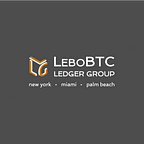THE IMPORTANCE OF SELF-CUSTODY
We live in volatile times (and I’m not just talking about crypto). Nobody knows what the outcome will be of the Russian invasion of Ukraine. There are many plausible scenarios, some of which are scary.
I take solace in safeguarding my family’s wellbeing. Financially, it means knowing where my assets are, how to access them, and what to do in emergency situations.
WEAPONIZED FINANCE
We have seen the impact of sanctions, frozen and seized accounts and assets belonging to individuals and entities deemed “enemies of the state”. Those targeted have ranged from Russian oligarchs to Canadian truckers.
Authorities can seize and freeze assets in banks, brokerages, vaults, and any accounts maintained by third-party custodians. It stands that nothing is really yours unless you have complete ownership and 24x7, uncensored access.
What that leaves you with is what’s on your person, in your physical possession, in a safe that only you have the combination to, and what’s in your head.
NOT YOUR KEYS, NOT YOUR CRYPTO
With digital assets, if you store your crypto with a third-party custodian, that account can be frozen and rendered inaccessible. But if you self-custody, meaning you own your private keys, then just like what’s in a safe in your house, access to those assets cannot be censored.
Ownership of cryptocurrency, such as Bitcoin, really just means the ability to transfer it, as digital-native assets are intangible. In order to transfer Bitcoin, one must use the private keys to move the BTC on the blockchain. What those private keys are (an alphanumeric string, often converted into a 12 or 24 word “secret private key recovery phrase”) and where they need to reside have spurred the development of sophisticated wallet software and hardware.
Self-custody wallets, however, are often not very user-friendly, making them difficult to use for the non-tech savvy. Companies such as LeboBTC Ledger Group (LLG), not only help clients invest in cryptocurrency, but help them self-custody by walking through every single step of setting up the wallet, securing it and using it.
WHERE ARE ASSETS TRULY SAFE?
If the current conflict in Eastern Europe is not making you question where assets are safest, then it is worth remembering the darkest moments of the 2008 financial crisis.
More than 30 European banks faced default unless they received bailout funds. In the US, over 700 banks received bailout money, with approximately 30 of the largest banks receiving between $1 billion and $25 billion each.
If all of those banks (where millions of people around the world held their family’s savings) had not been bailed out, it could have led to mass insolvency and bankruptcy. Money that was thought to be safely stored in checking and savings accounts was truthfully not there, as all banks operate in a fractional reserve system, meaning they loan out and invest most of their deposits. As evidenced by the financial crisis, sometimes those investments don’t work out and deposits are lost en masse.
Fast forward a decade to the global pandemic. Draconian quarantine measures (like those in China where citizens were not allowed to physically leave their homes) restricted the ability for one to go to a bank or ATM and withdraw cash or assets. Even if you were allowed to leave your home, in many cases bank branches were closed for months.
The government regulates the banks, and the banks are only open when they are allowed to and decide to be.
A more recent example in Canada illustrates the point clearly. “The Freedom Convoy”, a peaceful protest predominantly by Canadian truckers against COVID-19 mandates and restrictions, ended with the Trudeau administration seizing assets and freezing the bank accounts of hundreds of protestors. This extreme reaction by a Western democracy sent shock waves across the world, begging the question of “where are assets truly safe from the far reaches of government?”
The bottom line is that money held in a bank is not always as accessible as one may want or need.
PLANNING FOR THE FUTURE
Given the fragile state of the world right now, I believe it is a good time for all investors to go through each account they own in order to understand the true liquidity of their assets.
A smart way to analyze the liquidity of and access to assets is to break everything down into two buckets:
1. Accounts that are in name only, held by a third-party (e.g., checking/savings accounts; investment and retirement accounts; digital assets held by custodians, exchanges or any third-party, etc.), and
2. Assets in one’s actual possession and control (e.g., everything in your wallet/purse at any given time; assets held in a safe that only you have the combination to; digital assets which only you have the private keys to, etc.)
Given the prevalence of weaponized finance and sanctions occurring all over the world, there is a movement afoot towards self-custody of both physical and digital assets.
However, rising inflation is posing a large and growing problem for physical assets. For example, the current 7.9% inflation rate in the US means that $100 cash held in a safe or safety deposit box will only have the purchasing power of $92 in one year.
As I see it, the goal is to invest so as to beat 8% while maintaining custody of assets. That leaves very few ways to position oneself: own gold and/or other precious metals in a safe, and own digital gold (Bitcoin) and/or other cryptocurrencies in a wallet.
— — — —
For anyone who owns cryptocurrency or is considering investing in the space, do you choose self-custody, third-party custody, or a hybrid of the two? I’d be curious to hear from you on Twitter @LeboBTC
Join Coinmonks Telegram Channel and Youtube Channel learn about crypto trading and investing
